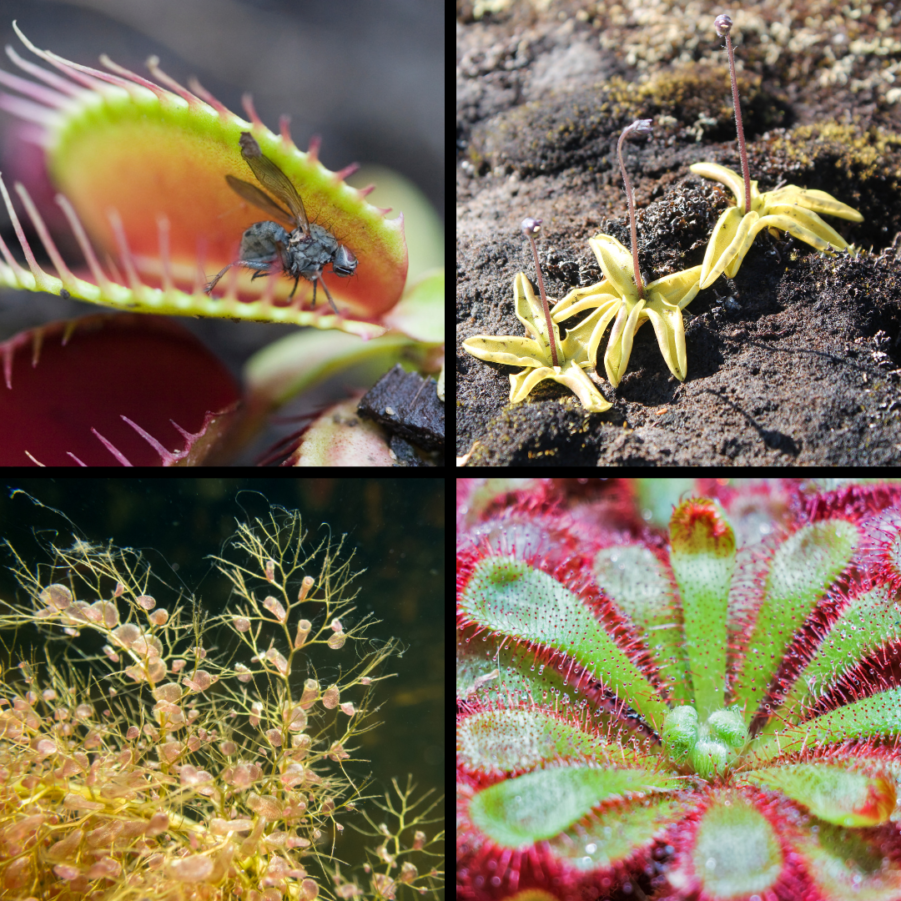Nature is filled with “exceptions to the rule”. Whenever we think we know something about the natural world, we are confronted with oddballs that break the mold. Carnivorous plants do precisely that. Although you may be familiar with the Venus fly-trap made famous by the musical Little Shop of Horrors, there are plenty of other examples of insect-munching plants around the world. Although they aren’t all related to one another, they share the bizarre trait of “eating” animals once in a while.
In this Wildlife Spotlight post, let’s learn about one of my favorite weird nature topics: carnivorous! Here, we’ll learn about why (and how!) they do what they do.
Looking for more weird nature facts? Check out this post!
What are carnivorous plants?
First off, it’s worth clarifying that “carnivorous” is a bit of a strong word in this context. Typically, the major plant groups included in this term consume mostly invertebrates like insects, spiders, or springtails. While “carnivorous” implies that they’re eating meat, scientists have observed few if any cases of vertebrates being consumed by plants. So, the way I see it, they’re not really eating “meat”.

Of course, plants can’t move around and grab prey, so they have to have some pretty clever strategies to get a meal. The result? Carnivorous plants have some of the fanciest, most heavily modified leaves in the plant kingdom. In particular, they use these for capturing animals which they then “eat” using digestive chemicals. As you’ll see below, these leaves make use of many highly effective strategies for nabbing tiny prey.
Carnivory is pretty rare in plants. In fact, of nearly 400,000 wild plant species on earth, only around 500 are carnivorous. That might explain why Western naturalists only became aware of carnivorous plants in the last couple of hundreds years. Fascinatingly, Charles Darwin, perhaps the world’s most famous biologist, was the first European naturalist to describe carnivorous plants. His 1875 book “Insectivorous Plants” was one of the first forays into the lives of these fantastic plants for Western audiences.
Why do these plants need to be carnivorous?
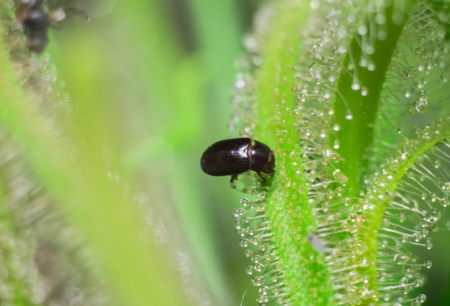
Casual nature lovers, professional biologists, and passionate naturalists alike are prone to asking the same question about carnivorous plants. Why do they need to eat animals to begin with? Most plants (with the exception of groups called saprophytes and parasites) can photosynthesize. In other words, they can collect energy from the sun using special pigment molecules, and use that energy to build food in the form of sugars. These sugars act as what we humans (as animals!) would call “food”; it sustains the plants metabolism and allows them to live.
Why are plants green in the first place?
So if plants “eat” by harnessing sunlight, what need do they have for an extra snack? As it turns out, photosynthesis is a great way to get chemical energy in the form of sugar molecules. However, it doesn’t help the plant get certain key nutrients that it needs. Most plants will get these nutrients, including Nitrogen and minerals like Potassium, from the surrounding soil via their roots. However, that strategy breaks down when a plant lives in places with poor or little soil.
Carnivorous plants solve this problem by digesting small animals, namely invertebrates, and “harvesting” the nutrients inside their bodies using digestive enzymes. Because of this, it’s more appropriate to think of them using these tiny critters like multivitamins, rather than like hamburgers. Even for a carnivorous plant, the majority of their energy needs are taken care of by sunlight. Instead, they get key nutrition from their carnivorous “diet”.
Where can you find carnivorous plants?
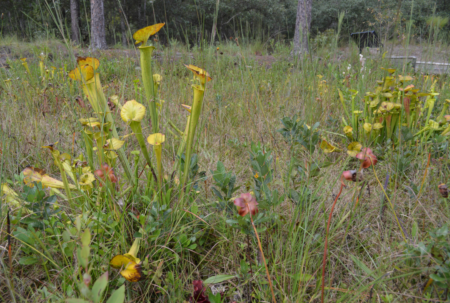
As we learned above, plants use carnivory as a way to get nutrients that they aren’t getting from the soil. As a result, carnivorous plants show up more often in places where soil nutrients are poor, or hard for the plant to access. In many parts of the world, this means wetlands: marshes, bogs, fens, seeps, swamps, and so-on. The water that accumulates in these habitats can make nutrients inaccessible to plant roots.
Carnivorous plants, with their ability to trap insects and other invertebrates like multivitamins, have a way around this problem. They can live in wet and low-nutrient places without worrying about not finding what they need. This makes wet, waterlogged habitats, even if they are only flooded for part of the year, an excellent place to find carnivorous plants.

Another challenging lifestyle for plants is living in the tree canopy. Epiphytes, which live on other plants, take up this lifestyle, and can have difficulty acquiring nutrients. Because of this, a great many carnivorous plants are also tree-dwellers.
Thinking more generally, you can find carnivorous plants on every continent except for Antarctica. There are a great many species in tropical Asia and America, and a smattering in North America, Madagascar, and Australia as well.
Curious about the biomes of the world? Check out this post!
6 Incredible Carnivorous Plants
1. Sundews
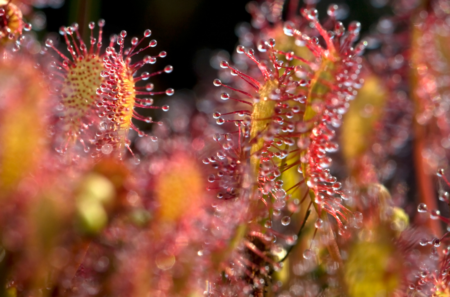
The sundews are a group of about 200 species in the genus Drosera, and were among the first carnivorous plants studied by Charles Darwin in the 19th century. Their Latin name comes from the Greek word drosos, meaning dewdrops. Sundews probably have the prettiest name of all carnivorous plants, and it’s a well-deserved one. Their leaves are covered in beautiful hairs, each tipped with a little drop of clear liquid.
This “dew”, although gorgeous in the sunlight, is actually the business-end of an insect-killing machine! The hairs (or trichomes as plant experts call them) have special glands which secrete liquid. The liquid is actually very thick, sticky, and viscous. As a result, it functions much like flypaper! Insects that land on the leaves or brush up against them will get stuck to the dewdrops from these glandular hairs.
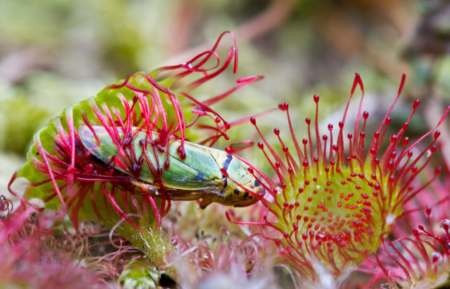
Once that happens, the plant’s leaf will start to fold inward, putting more and more hairs and their sticky globs in contact with the insect. This detains the insect, holding it firmly in place, and can eventually suffocate it. Over the next few days or weeks, the plant will secrete digestive enzymes to break down and absorb nutrients from its unfortunate victim. When the “meal” is done, the leaf opens up again. Next!
Sundews may be the most widespread carnivorous plants. You can find them all over the world, with cool species in temperate Europe and North America. Australia boasts two cool subfamilies of this group, one found in wet tropical areas along the East coast, and another that amazingly survives the hot, dry deserts of the Southwest!
Learn more about Australia’s weirdest wildlife
2. Pitcher Plants
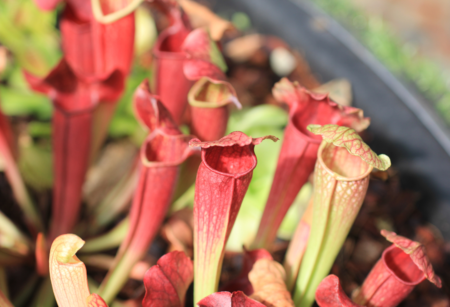
Pitcher plants are carnivorous plants that use rolled-up leaves shaped like cups or pitchers to capture their animal prey. These pitcher leaves often have attractive colors to draw in insects, and may even imitate the scent of flowers. When insects investigate the cup-leaf, they may fall inside, unable to get a foothold on the slippery rim. Pitcher plant leaves hold a small quantity of water, known as the phytotelmata inside. The unfortunate bugs that get caught inside may drown in this water as they struggle to escape.
Depending on the species, some have a cap which can cover the “cup”, or false exits to make escaping more difficult. Furthermore, many plants will have waxy secretions, hairs, or textured ridges on the inside of the cup that make it hard to climb out. Once the bug has died inside, it will break down inside of the phytotelmata, either by the action of bacteria in the water or enzymes secreted by the plant.
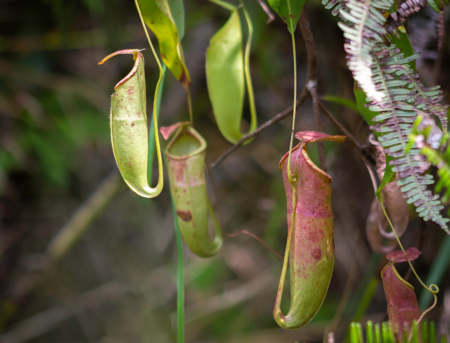
Several different and unrelated groups of plants use pitcher-shaped leaves, so the common name “pitcher plant” includes a bunch of different species. This is kind of like how the term daddy long legs gets very confusing for the number of different animals that it refers to.
Learn why scientific names can make nature study less confusing
Two families make up most of the species in this group. The huge family Nepenthaceae, also known as the tropical pitcher plants or monkey cups, with around 170 species, and the Sarraceniaceae with a few dozen. The tropical pitcher plants’ leaves are often on the end of a vine-like tendril, and typically hanging. By contrast, the Sarraceniaceae have pitcher-shaped leaves that come up from the ground like organ-pipes. The first of these groups is widespread in tropical Asia and Madagascar, while the other is found in North America. Other highlights include the cobra plant Darlingtonia in California, and Cephalotus follicularis, the Albany pitcher plant, a highly unique species in Australia.
3. Bladderworts
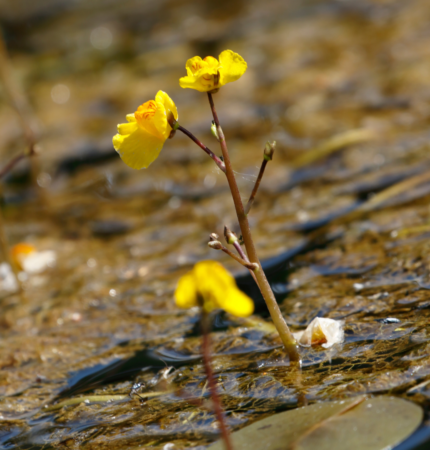
Bladderworts (genus Utricularia, try saying that 5 times fast!) are one of the more unconventional groups of carnivorous plants. Unlike the other groups we’ll cover in this post, bladderworts consume almost entirely aquatic invertebrates. In other words, they do their “hunting” in the water! This big genus (of more than 200 species) also occurs on all continents except for Antarctica. They occupy all kinds of freshwater habitats, and, as you might have guessed, are only really absent from desert areas like Western Australia, the American Southwest, the Middle East, and West Africa.
Above the surface of the water, bladderworts are handsome and fairly innocent-looking herbs, often with tall, slender stalks ending in light colored flowers. Most of the bladderworts I’ve noticed in my outdoor travels have had bright and showy, yellow flowers that have cool and complex structures. People often compare these gorgeous flowers to snapdragons in the garden, but for bladderworts the real excitement occurs below the surface.
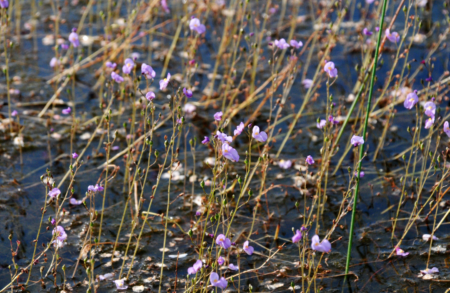
Bladderworts have underwater leaves that have hollowed out chambers (the bladders) which act like traps. These tiny chambers (typically a miniscule fraction of an inch, but some as big as a half-inch or 1.2cm) have a trapdoor with a sensitive trigger. When a swimming invertebrate passes by this trigger, the trapdoor springs open. Because the plant has pumped water and air out of the chamber, it forms a vacuum, which sucks the prey inside.
Tiny invertebrates like rotifers, water fleas, and springtails get sucked into the trap, where they will be broken down and digested. Even larger organisms like baby fish or mosquito larvae, if part of their body is caught, will also be “eaten”. Who would have thought that a gorgeous flower could also provide mosquito control?
Are mosquitoes attracted to colors?
4. Venus Flytraps

The Venus flytrap (Dionaea muscipula) may be the world’s most famous carnivorous plant. Interestingly, this poster child for bug-munching plants is exceedingly rare and occurs in only a very small part of the world. Specifically, Venus flytraps are native only to a small area coastal plain of the Carolinas in North America. However, their unique method of “feeding”, beautiful leaves, and (relatively) easy care have made them charismatic as houseplants.
Venus flytraps have modified leaves with a hinge in the middle and two main lobes. Those lobes are reddish to attract insects, and secrete sticky chemicals that attract insects. The outer edges of both of the lobes are lined with stiff hairs that look like eyelashes. Inside of the lobes, small sensory hairs can feel when an insect has entered inside. If the insect brushes up against more than one hair within a few seconds’ time, the two lobes snap shut!
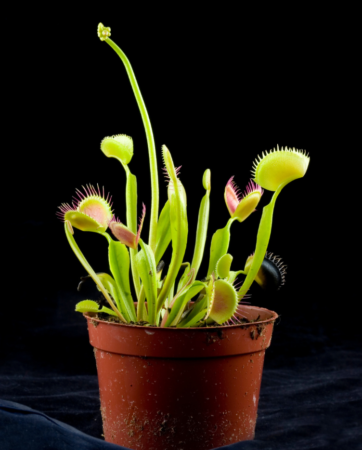
Want a Venus flytrap of your own? Check out these options on Amazon!
When this happens, the hairs on the outside of the leaf interlace, forming a cage. Over the next couple of weeks, the leaf seals itself closed, and digestive fluids break down and absorb nutrients from the captured insect.
Unfortunately, these fascinating plants are considered endangered due to their highly restricted range and poaching by plant hunters.
Why is it bad when species go extinct?
5. Butterworts

Butterworts (genus Pinguicula) are beautiful and unimposing little plants that look a lot like violets (Viola sp.). Belonging to the family Lentibulariaceae, they employ a strategy much like sundews, but are entirely unrelated to them. These pretty little plants occur in Europe, North America, and temperate regions of Asia. Although not particularly easy to find, there is also a large diversity of Pinguicula species in tropical America.
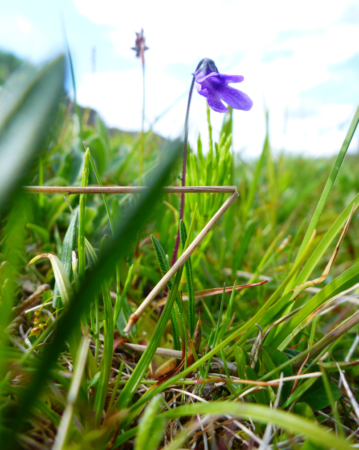
Butterworts’ stubby, fat leaves typically form a rosette, or circular pattern around where the roots are growing. Their taller flowers are often purple or pink. Their cute, rounded leaves are covered in short hairs which, like those of the sundew, can trap and ensnare insects with their sticky secretions. Unlike sundews. these hairs and their droplets of trapping glue are very small and hard to see. You’ll need a hand lens or magnifying glass to see them well!
Gulo in Nature’s guide to using a magnifying glass
Butterwort’s leaves also don’t curl up to trap insects as sundews’ do. This, and their smaller hairs, means that they can typically only capture smaller or weaker insects.
6. Corkscrew plants
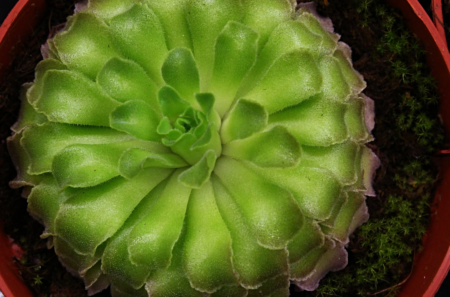
Corkscrew plants are a small group of tropical carnivorous plants that, like bladderworts, feed on animal prey beneath the surface. In their case, the 30-odd species of corkscrew plants eat really tiny animals, like protozoans or nematodes in the soil. Like many other tropical species, these plants, which belong to the genus Genlisea, were not described by Western scientists until very recently. In their case, carnivory in corkscrew plants was not fully demonstrated until 1998! These poorly understood plants belong to the same family as butterworts and bladderworts, Lentibulariaceae.
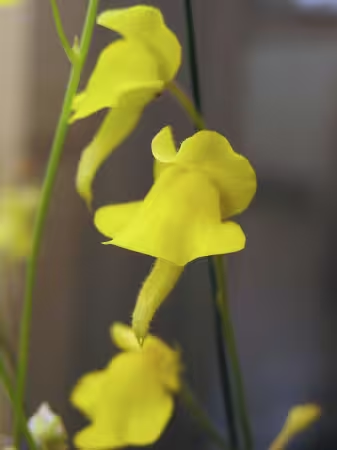
Fascinatingly, corkscrew plants have no roots, but have bizarre, corkscrew-like leaves that grow below ground and perform many of the same functions. Since they grow underground, the leaves don’t need any chlorophyl, and are completely white. Their spiral shape provides grooves which are the main entrance points for microscopic animals. As they pass into the grooves, series of backward-facing hairs prevent the animals from coming back out, much like a lobster trap.
Do lobsters really mate for life?
Corkscrew plants are some of the least known carnivorous plants, and their carnivory is hard to recognize since it takes place underground. Their prey items, which consist of nearly tiny metazoans, are also not particularly charismatic. That leads some scientists to describe them as the forgotten carnivores among plants.
Thanks for reading about carnivorous plants!!
Got another reader request for a post in Gulo in Nature? Drop us a line using the Contact page. If you enjoyed this post and want to support the blog, please share with others and follow us on social media!

